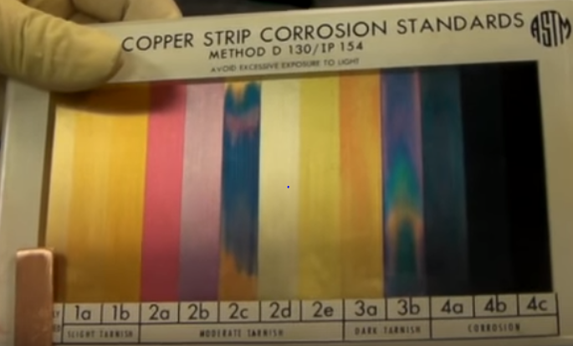What is it?
The copper strip corrosion test measures the corrosivity of hydrocarbon liquids. It is a subjective test based on the discoloration and corrosion of a copper coupon under standard test conditions when compared to a series of ASTM standards. Passing the copper strip corrosion test is often a condition of hydrocarbon liquid product sales contracts. There are several different copper strip corrosion tests for different categories of hydrocarbon liquid products:
- ASTM D130-19 – Petroleum products (gasoline, aviation fuel, kerosene, diesel, fuel oil, natural gasoline)
- ASTM D849-15 – Industrial aromatic hydrocarbons
- ASTM D1838-16 – Liquefied petroleum gases
Why do products fail the copper strip corrosion test?
Elemental sulfur and reactive sulfur species such as hydrogen sulfide and mercaptans in the liquid hydrocarbon will react with the copper test coupon and cause the product to fail the test. A mixture of sulfur contaminants will generally cause worse corrosion than a single contaminant alone.
Carryover from upstream sulfur removing processes such as caustic scrubbers can lead to copper strip corrosion test failures. Water carryover from amine systems may react with carbonyl sulfide to form hydrogen sulfide causing a test failure even after amine treatment for hydrogen sulfide removal.
Amine and glycol amine carryover can mask copper corrosion in a sample taken directly from the amine treater system. A sample from the same product taken from a storage tank may later fail the corrosion test after the amine carryover has more completely separated from the hydrocarbon and no longer masks the corrosivity of residual sulfur contaminants.
How can SulfaTrap help?
SulfaTrap™ sorbents eliminate hard-to-remove compounds such as carbonyl sulfide, mercaptans, and organic sulfides from liquefied petroleum gases, natural gas condensate, natural gasoline, refined gasoline, diesel and biofuels.
SulfaTrap™ sorbents are solid sorbents eliminating the potential for water, amine, or caustic solution carryover from the sulfur removal process. Our systems are ideally suited for polishing and deep sulfur removal downstream of conventional bulk sulfur removal processes.
SulfaTrap™ sorbents physically adsorb sulfur compounds from the hydrocarbon liquid without producing elemental sulfur. The sorbent contacts the liquid in a packed bed reactor so there is no slurry handling or filtration required for sulfur removal.

